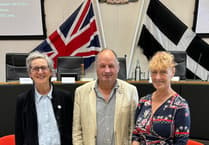The other Saturday I sat down in front of the television to watch Trooping the Colour. It is something I have done for many years. I started watching it as a child in the hope I might learn something to help with my ambition to work in broadcasting.
I’ve always been fascinated by the way the television coverage was produced.
I wanted to understand every aspect of covering a major event, from the camera angles to the commentary.
Commentating on a big occasion, whether it’s a Royal ceremony or a football match, is an incredible skill. I am in awe of all sports commentators. You really have to be on the ball, no pun intended!
Recently I did some teaching alongside a well-known Match of the Day commentator and he would always say to the students: “Fail to prepare, prepare to fail”.
Preparation is key to providing good commentary. I did commentate on a few Royal occasions here in the South West, notably the late Queen’s Golden Jubilee visit to Exeter Cathedral.
The day before the visit I went to the Cathedral with our director and producer so we could view where the Queen would be and what would be happening.
We’d already drawn up a plan based on what we’d been told weeks earlier by the Palace. But when we got to the Cathedral we realised we needed to change everything otherwise the cameras wouldn’t get the necessary shots.
I can remember the whole production team sitting in my small hotel room the night before the big day, with plans of the Cathedral and copious notes and running orders spread out across the bed. It was a late night as we rejigged our plans.
So, as I watched Trooping the Colour this year I had a small idea of what had gone into preparing for the television coverage. The commentator was Clare Balding and she did a fantastic job.
Her comments were informative and not too intrusive. It is often hard to judge when to speak and when to keep quiet.
Early on in my career I commentated on the presentation of new colours to the Royal Marines on Plymouth Hoe and I learnt from the viewer feedback not to talk over too much of the music in future.
Striking the correct tone is also a challenge. Fans of Royal and state occasions are sticklers for accuracy and will also expect the coverage to have due reverence.
But during my career we were also increasingly mindful of the number of people who had little or no time for these events and felt our coverage was fawning and over-the-top.
Getting the balance right is not easy. I can remember the BBC bringing in some young and “trendy” presenters to cover the Queen’s Diamond Jubilee in a bid to appeal to a broader audience. It was a disaster because they got the tone of the event wrong.
But, all these years later as I watched coverage of Trooping the Colour I started wondering if a change in the tone and style of these events is now overdue.
For the first time I was struck by how bizarre it all was and whether it’s still relevant in this modern digital world.
Clare Balding explained that certain aspects of the ceremony dated back to ancient times when soldiers needed to recognise their flag on the battlefield and communications were often by drum or a horn.
To add to the out dated feel of it all, the Royal Family made their way to the ceremony in horse drawn carriages, but it was pouring with rain, so the carriages had the hoods up. Strangely the hoods didn’t fully cover some of the carriages and lesser Royals were left to get wet while the others couldn’t be seen.
Surely one of the key purposes of the day is for the Royals to be seen!
Since these ceremonies were first devised the car has been invented. Surely it is time to stop using horse drawn carriages. And when did a soldier last need an elaborate ceremony to be shown the regimental colour so it could be recognised on the battlefield? After all, it is 2024 not 1824.
Don’t get me wrong, the precision and spectacle of the marching and the music were as superb as ever. There is no doubt we know how to put on a truly impressive military parade in this country.
But is this ceremonial work a good use of soldiers’ time? At one point a military expert who was providing the commentary pointed out that many of those on parade had been taken away from frontline duties for the last seven weeks to rehearse for Trooping the Colour.
I have been trying to work out why I felt slightly uncomfortable watching the King’s Birthday Parade this year. I have always supported the idea of Monarchy and always respected our traditions and heritage. So why did the carriages, the gun salutes and the elaborate marching all suddenly feel out dated?
I think it was because of the backdrop of the cost of living crisis, the feeling that so many of our public services are not working and a general feeling that a lot of people are struggling with the day-to-day bills.
Can we afford these big state occasions? For me this year it just felt a bit out of step with modern life.
But, at the same time I know these events can still create a sense of national pride and lift the spirits, so perhaps in some ways we need them more than ever!
It has long been suggested the King wants to modernise the Monarchy and it was noticeable how few Royals were on the Palace balcony this year compared to previous years.
I suspect over time there will be a very slow and subtle change to big Royal events such as Trooping the Colour. I imagine it will be very gradual though, nothing to frighten the horses (or the occupants of their carriages!)
Bye for now.





Comments
This article has no comments yet. Be the first to leave a comment.